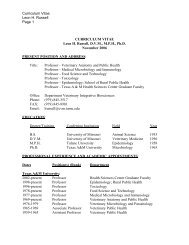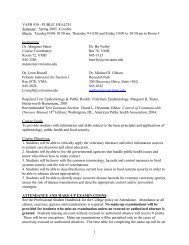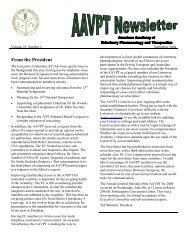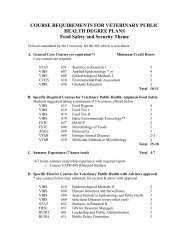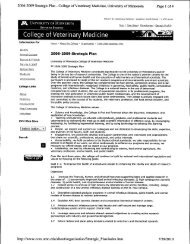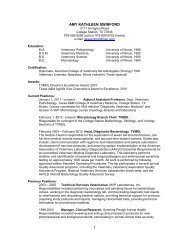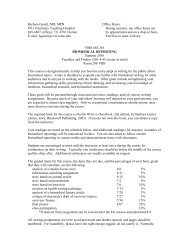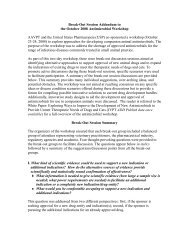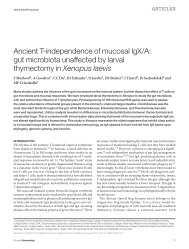Disaster - College of Veterinary Medicine - Texas A&M University
Disaster - College of Veterinary Medicine - Texas A&M University
Disaster - College of Veterinary Medicine - Texas A&M University
You also want an ePaper? Increase the reach of your titles
YUMPU automatically turns print PDFs into web optimized ePapers that Google loves.
Communicating<br />
Continuing Education<br />
program presents first<br />
farmed deer conference,<br />
among other new trends<br />
FThis year, the Continuing Education Office <strong>of</strong> the <strong>Texas</strong> A&M<br />
<strong>College</strong> <strong>of</strong> <strong>Veterinary</strong> <strong>Medicine</strong> & Biomedical Sciences (CVM)<br />
held a conference focusing on “<strong>Veterinary</strong> Opportunities with<br />
Farmed Deer.” This is the first time this topic has been highlighted<br />
in continuing education efforts in any veterinary college<br />
across the nation. Attendees arrived from all over the country<br />
to learn how they can diversify their veterinary medical practice<br />
and improve their bottom line.<br />
The conference resulted from a collaboration between the<br />
<strong>Texas</strong> Deer Association (TDA) and the Continuing Education<br />
Office and provided education for veterinarians about the growing<br />
farmed deer population and the implications for this new<br />
growth area on the veterinary industry. Since its formation in<br />
1999, TDA has seen a huge growth in whitetail breeders in <strong>Texas</strong><br />
from 350 to 1200 today. In a 2007 study, agricultural economists<br />
from <strong>Texas</strong> A&M discovered that farmed whitetails ranked<br />
sixth in agricultural products bringing in $652 million to the<br />
<strong>Texas</strong> economy. The national economic impact is in excess <strong>of</strong> $3<br />
billion.<br />
With growth brings the opportunity to expand veterinary<br />
medical practices to fulfill the demand for large animal specialization,<br />
especially as the farmed deer industry continues to<br />
seek veterinary expertise and support. The conference focused<br />
on practices, health issues, regulations, treatments, and discussions<br />
for the farmed deer industry, as well as how these may be<br />
incorporated into large animal veterinary practice. The overall<br />
message, however, was very clear—the opportunity to add a<br />
valuable client base to established large animal clinics is a way to<br />
keep practices growing in difficult economic times.<br />
with clients, students, veterinarians,<br />
other scientists, & the public<br />
by Elizabeth Janecka<br />
In addition to the deer conference, the Continuing Education<br />
Office <strong>of</strong>fers a wide variety <strong>of</strong> learning topics throughout the<br />
year.<br />
“We want the Continuing Education Office <strong>of</strong> the <strong>Texas</strong> A&M<br />
<strong>University</strong> <strong>College</strong> <strong>of</strong> <strong>Veterinary</strong> <strong>Medicine</strong> & Biomedical Sciences<br />
to be the premiere learning experience for veterinarians who<br />
need to receive their continuing education,” said Beth Johnson,<br />
coordinator <strong>of</strong> continuing education. “We <strong>of</strong>fer world renowned<br />
faculty and state <strong>of</strong> the art equipment to help teach the courses.<br />
We have also worked really hard to provide topics and content<br />
that will accommodate most, if not every, veterinarian. While<br />
some topics are <strong>of</strong>fered every year with a different focus, we try<br />
our best to <strong>of</strong>fer new conferences to best feature the latest trends<br />
in veterinary medicine.”<br />
“Last year, there were 859 individuals from all over the country<br />
who attended our conferences,” explained Johnson. “We awarded<br />
310 continuing education hours to veterinarians. Each veterinarian<br />
is required to have 17 hours a year from the <strong>Texas</strong> Board <strong>of</strong><br />
<strong>Veterinary</strong> Medical Examiners, while a registered veterinarian<br />
technician is required to have five hours. We keep all <strong>of</strong> their<br />
contact information and continuing education hours in a database<br />
so that at anytime an attendee can call and get that information<br />
verified. We try to provide a supportive environment so that<br />
we can be as helpful as possible to the attendees.”<br />
Please refer to the CE website (vetmed.tamu.edu/ce) and the<br />
Continuing Education Calendar on page 5 for upcoming events<br />
and new conference dates.<br />
CVM Today • Summer 2010 • 11




